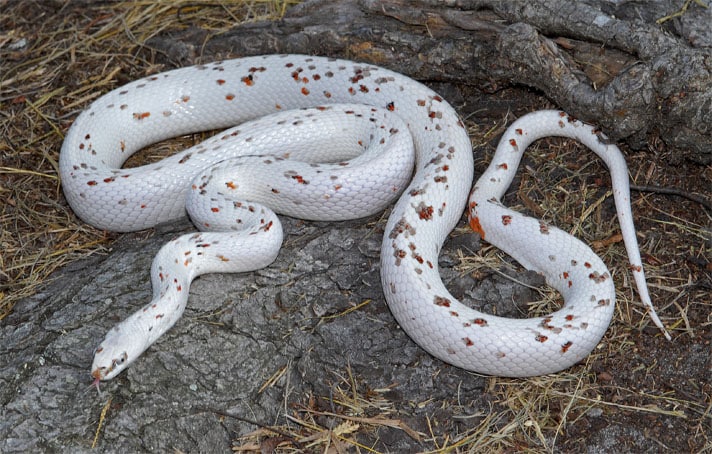Corn snakes are still one of the most popular snakes in the hobby.
In the known universe, is there anyone left who’s unfamiliar with the world’s most popular pet snake? Although I’m doubtful, just in case you haven’t yet been initiated into the joy of working with them, this article has the basics of corn snake care in a large nutshell. This information is based on more than three decades of personal experience keeping and breeding corn snakes in my home, and as a herpetocultural enterprise.
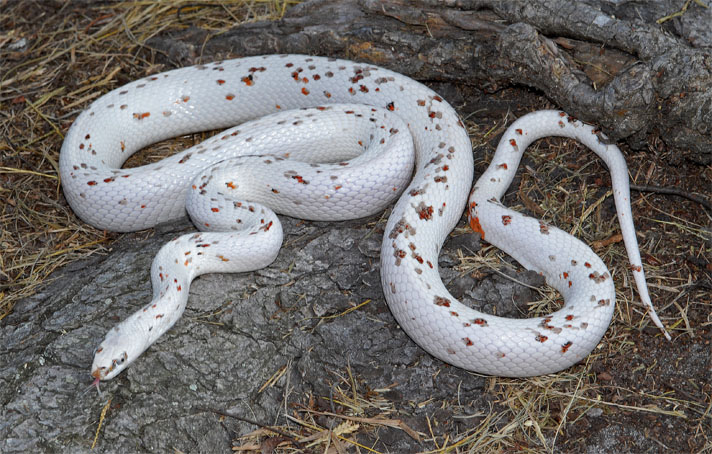
bill love
Palmetto corns are uncommon. Most color is gone, leaving a white snake with random red and black scales and splotches.
Corn snakes have it all—beauty, convenient adult size for handling and housing, calm temperaments, incredible genetic variety and ease of captive propagation. You can enjoy the best aspects of snakekeeping, with an excellent prospect for success in reproducing more. Other keepers will nearly always be eager to acquire your surplus offspring.
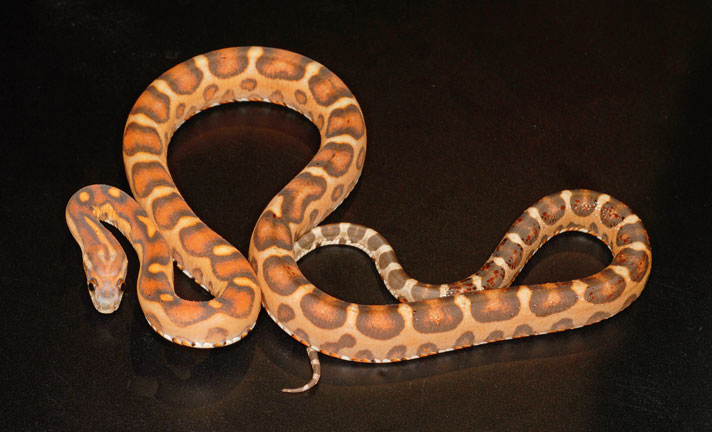
bill love
Even scaleless corns have a few scattered scales. Look for these to be available in the near future.
The corn snake’s common name comes from the rodents it seeks while living in and around cornfields and cribs, and also from its belly markings, which resemble Indian corn. Previously known by the Latin name Elaphe guttata, recent taxonomic work moved all North American rat snakes, including the corn snakes, into the genus Pantherophis and the species guttatus.
Choosing a Corn Snake
When selecting a new snake, watch for these potential problems as you examine prospective pets:
- Too thin (ribs or backbone protruding) or too flaccid (poor muscle tone). Check for “mushy” bellies and rear ends, and for odd lumps, body kinks or indentations. Listless, weak specimens are always a poor risk to buy. The best way to check for these is to run the entire length of a corn snake’s body through your gently closed hands to feel for irregularities.
- Respiratory infections. Listen to the snake’s breathing for any hint of whistling or gurgling, and look for puffiness around the throat. Are there liquids or bubbles coming from the nostrils or mouth? These are signs of possible infection.
- External parasites. Look for “bugs” attached anywhere on the snake’s body. Wipe your hands firmly down the snake’s body to see if anything clings to them, and check for ticks, especially around body orifices.
- Irritability/nervousness. It’s normal for hatchlings to defend themselves against a large, formidable object, such as your approaching hand. This kind of aggression is to be expected and should fade quickly as they mature and learn to trust that you’re not a threat. Adult corns virtually always have a calm demeanor, but certain rare individuals may be high-strung and nippy, especially when first held.
- Recorded history. Ask if written records were kept on a snake in which you’re interested. What does it eat? How often? How big of a feeder rodent? Under what conditions—time of day, temps, method of food introduction, etc.? A lack of records isn’t necessarily a sale stopper, but records show competence on the part of the previous owner or breeder.
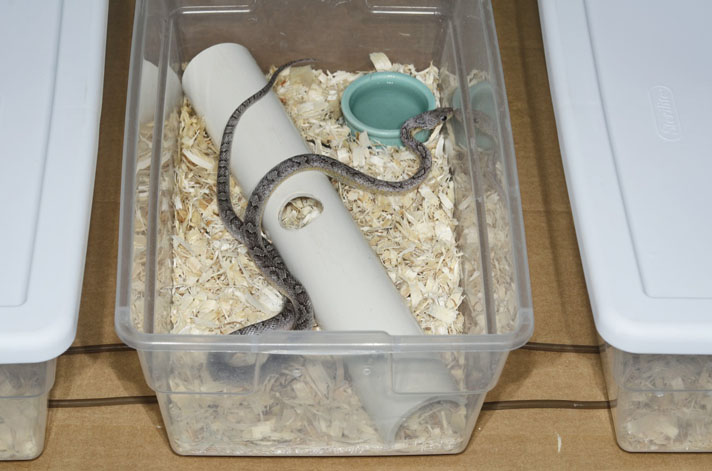
bill love
The long, narrow, PVC provides a secure hide, and this baby corn is able to choose between the warm end over the heating cables (the brown strands beneath the box at the bottom of this photo) and the opposite, cooler end as desired.
Hatchling corns are somewhat more fragile than adults and need more time to adjust to handling. But they are cheaper and available in many more attractive colors than adults. Babies typically grow to adult size in about 2 to 3 years, so it is worth the trouble to get exactly what you want.
Older corns are big and impressive, but their colors are often duller and darker than young adults. Healthy looking adults may be found for sale for many reasons, but as with used cars, beware of hidden flaws, such as reproductive failure. A husky, 5-foot-long corn snake may appear to be an instant breeder size-wise, but that should make you at least consider why it was not kept for breeding by the person who raised it.
Ideal Corn Snake Housing and Enclosure Requirements
If your new acquisition has some of its original cage bedding in the sack or cup it arrives in, place that under the hide box in its new home, so some familiar scent is evident. The new home should be ready well before its occupant arrives.
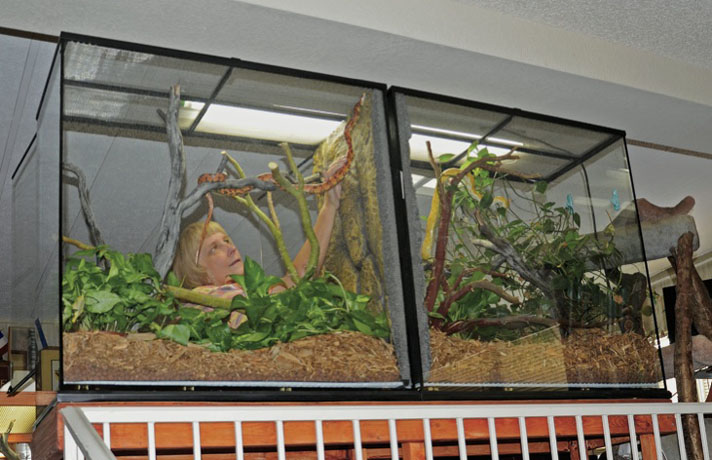
bill love
The author enjoys keeping some of her corn snakes on display in large vivaria, decorated with live plants, inside her home.
The minimum size enclosure for a single adult corn snake should have the dimensions of a standard 20-gallon long aquarium—12 inches wide, 30 inches long and 12 inches tall. Plastic shoeboxes or vivaria can work for juveniles until they reach about 18 inches in length.
Resist the temptation of excessive handling with new acquisitions, especially babies. Wait for at least three days before offering food to reduce the likelihood of regurgitation from a nervous new pet.
When considering a cage, be sure the inside surface is impervious to moisture and can be cleaned. Decide how it can be heated, ventilated and whether the viewing area is satisfactory for your needs. A screen lid, or a minimum of two separate openings measuring 4 square inches, should be present on different sides of the cage for adequate air exchange. Holes should be no larger than one-eighth inch with a non-abrasive texture to avoid injury when the snake rubs against them, looking for potential escape points. Corn snakes’ climbing agility and expertise at squeezing out of tiny cracks and openings is nearly legendary. If a corn snake can escape, it will escape! Using an escape-proof enclosure must be a primary consideration when purchasing or building a home for your corn snake. Baby snakes can often escape from cages made for adults, so check carefully, especially around sliding glass doors, for any gaps.
Aspen bedding is a pale, shredded wood fiber with little dust or scent that works particularly well for cage bedding. It’s absorbent, keeping the solid and liquid portions of feces concentrated for easy scooping and removal. Aspen’s interwoven nature also allows corns to tunnel through it while exploring, providing them hiding places in the “caves” formed beneath it.
Cypress mulch (commonly used in gardening in the south) also works well because it shares many of the same properties as aspen. But not all kinds of similar mulch are good for reptiles. Avoid using any bark or resinous wood mulches, such as cedar, pine, fir and walnut, that have toxic aromas or oils; these are especially dangerous to juvenile corn snakes or snakes kept in cages with low ventilation.
Corns like to squeeze into tight, dark places in order to feel secure from predators while digesting their food, in shedding cycles, when gravid or just resting. A hide that is dark and in which the snake barely fits will provide it with the most security. If it is two or three times longer than it is wide, it can be heated via undertank heat pad or cable under one end only, leaving the snake a choice of being warm or cool without leaving its secure hide.
Humidity for Corn Snakes
The simple rule to remember about maintaining proper humidity is that if the snake is having problems shedding, it is too dry. However, if there is water condensing and running down the glass, the enclosure is too wet. If neither condition occurs, your snake is probably happy with the humidity level.
Juvenile corn snakes are much more prone to desiccation than adults, especially when kept in dry climates or in air-conditioned or heated homes. Humidity may be controlled by covering varying amounts of the main ventilation areas of the cage to increase or reduce moisture loss by evaporation. Simple newspaper on top of a screen aquarium lid often works well. While some keepers may use plastic wrap, it can restrict air flow too much. I recommend paper.
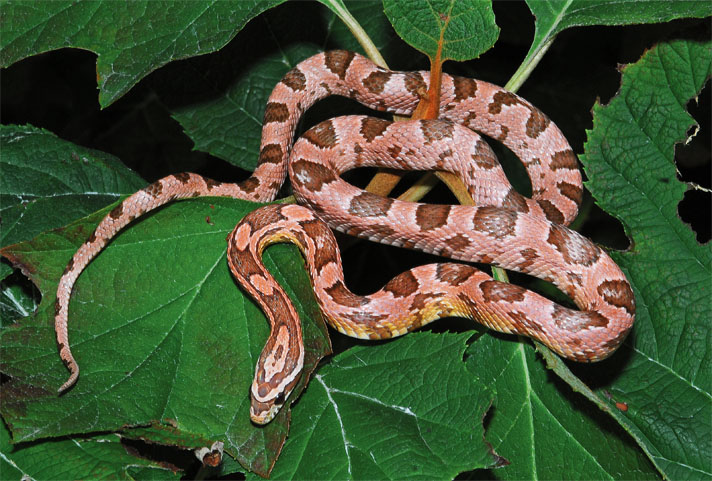
bill love
Salmon corns result when combining strawberry with anerythistic to intensify the pink ground color.
A small, 3- to 6-inch-diameter, sturdy water bowl for drinking is all that’s normally required by healthy corn snakes. Place it in a corner for new babies, so that when they cruise cage perimeters, they find it easily. Place it in the middle for adults because they are more likely to soil items on the perimeter.
Provide a moist hide when a snake’s eyes turn a milky blue before skin shedding. Thoroughly wet, and then squeeze out, a handful of sphagnum moss or similar material, and place it under the hide. It will help moisten the snake’s skin and aid in shedding. Remove the material after the shed to avoid a buildup of bacteria or fungus.
Corn Snake Heating and Lighting
Corn snakes thrive at moderately warm temperatures in the range of 70 to 88 degrees Fahrenheit. Unlike humans, who have self-regulating body temperatures, snakes can’t sustain all bodily functions if kept at any one temperature constantly. Higher or lower temperatures will facilitate natural functions, such as digestion, embryo development, and parasite or infection control. Thermoregulation is the freedom-of-choice process by which snakes purposely move in and out of areas of higher or lower heat to optimize their body temperatures for various functions.
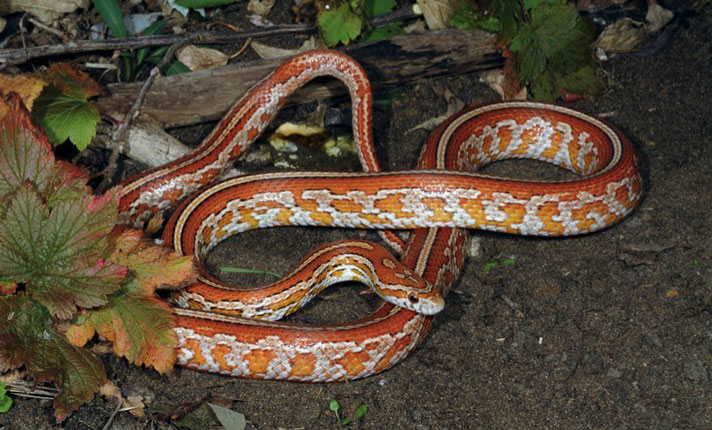
bill love
Tessera corns—a dominant trait—sport a lined dorsal pattern; like striped, but with more side pattern than the original striped morph.
Basking in sunlight is the method corn snakes use most often in nature. Denying this vital freedom of choice is surely an important factor behind many of the health problems that arise in the often-restrictive, constant environments that many keepers provide for their pets in captivity.
The most popular method of offering heat to a limited portion of a cage is through a heating device under or inside one end of the enclosure. Use undertank heaters manufactured for herps instead of human heat pads, which are not made for constant use. Reptile heat tapes and cables are also available and are made specifically for using under plastic or glass cages. Avoid anything that would require electrical cords inside the vivarium.
Spotlights may also be used to direct incandescent light to a special basking rock or branch that the snake can utilize easily. Be sure that such a source of radiant heat is aimed at only one end of the cage, so a cooler and darker retreat exists at the far end. The basking temperature on the perch site directly under the lamp (or area directly above the undertank heater) should be around 90 to 100 degrees, so the snake can get hot enough, but only when utilizing the hottest basking spot available.
For general illumination, use bulbs that look as close to natural light as possible. A CRI (Color Rendering Index) above 90 will show off a corn snake’s natural colors better than less natural light. In a well-lit room, no extra cage lighting is needed.
What to Feed Corn Snakes
After their first shed, baby corns are ready to be offered food. Try a single pinkie (newborn) mouse, not a rat, at first. A pinkie that’s less than five days old is enough of a meal for a 10- to 12-inch snake. Lay the pinkie in the cage near wherever the snake is hiding, preferably without disturbing the snake in the process. Do not offer more than one item, do not drop the pinkie on top of a snake or place it inside the hide box (doing so may scare the snake).
Many young snakes will immediately eat previously frozen, thawed pinkies, but some will need a few feedings of live pinks to stimulate their interest. Under ideal digestive conditions, complete digestion will occur within two to three days. Optimal hatchling feeding is approximately one pinkie every five to seven days.
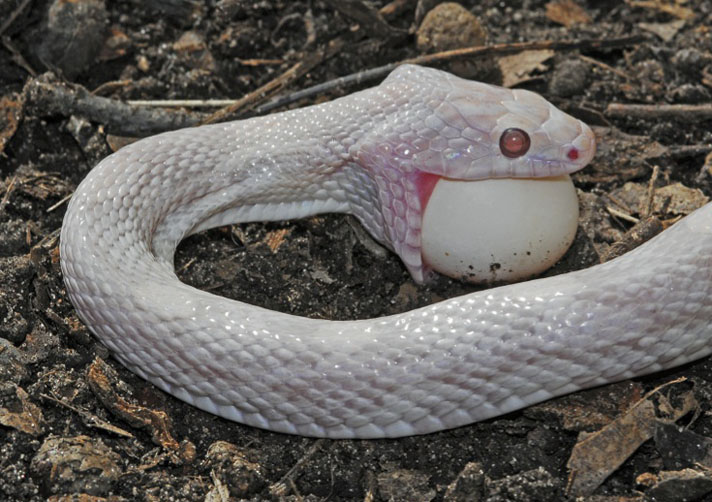
bill love
Corn snakes are usually too small to eat chicken eggs, but eggs from smaller birds, such as finches and quail, will often be taken if some of the original scent remains, or if they are scented with something else that appeals to your snake.
Corn snakes larger than 3 feet in length feed almost exclusively on larger mice, or small rats for extremely large specimens longer than 4½ feet. Food size should be such that the stomach bulge is noticeable, but not huge, after eating. The first defecation after the most recent meal comes two to four days after eating, depending on temperature. At that point, the snake is often interested in eating again, but it’s not necessary to feed large corns immediately after they defecate. In nature, corn snakes could easily spend the next week in search of food, receiving plenty of exercise in the process. One rodent every one to two weeks is a perfectly fine feeding regimen for most healthy adult corn snakes. A good general rule of thumb is to let all snakes rest—no handling or bothering them in any way—for three days after any meal.
Corn Snake Growth and Maturity
Baby corns can grow really fast! Adulthood is a factor of size, not age, in corn snakes. Reproduction in females much smaller than 3 feet in length is a strain on young corns due to the significant weight loss and dehydration that will affect their barely mature bodies during the process. Besides a tendency to lay only a few large eggs, the susceptibility to egg-binding and other reproductive problems is higher than normal, too. These are good reasons to keep the sexes apart unless they are ready to breed.
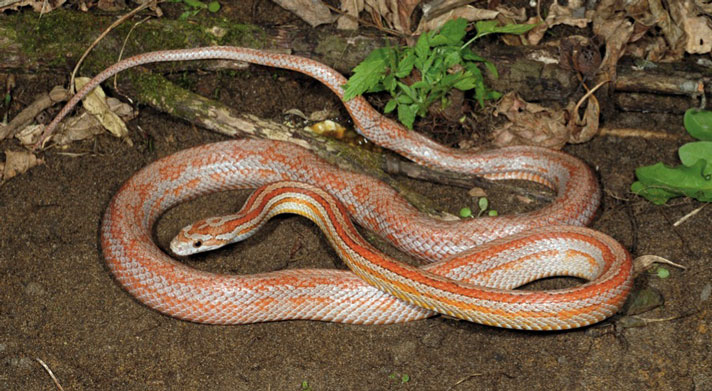
bill love
Terrazzo corns have a simple, recessive gene in which the dorsal pattern sports an Aztec-like stripe and breaks up toward the tail. The belly is generally patternless, but it is not related to striped or motley corns.
Male corn snakes grow longer and heavier than females. The biggest males top out at 6 feet and about 2 pounds in weight. Most corns longer than 4½ feet are males, and corns longer than 5 feet are seldom seen in captivity. Growth and shedding frequency steadily slows down after maturity, but both seem to continue almost imperceptibly for the rest of the snakes' lives. After about five years of growing, you can assume that your mature corn snake will not grow significantly longer.
Shed Well
Snakes periodically shed their skins, usually about two to four times per year. The old, less-flexible outer layer is replaced with a newer, cleaner and more-elastic layer of skin as they grow. Corns shed more often when fed heavily and in response to skin injuries. In healthy corns, the old skin comes off in one complete piece with every detail of its owner’s scalation intact on the moist, flimsy white “stocking.” Shedding in pieces may indicate a lack of humidity or some other problem.
The full shedding process takes about a week from start to finish. One day the snake's colors suddenly appear much duller than usual. Within a day or two, its eyes cloud over with a milky or bluish cast. After several more days, the eyes will look normal again for an additional several days prior to the actual molting. Most corns do not want to be handled or fed while they're shedding, and they may be more likely to regurgitate food if they do eat.
The Beauty of Corn Snake Morphs
Corn snakes are naturally very pretty, but many wild ones have attributes that obscure or muddy their beauty. Most often, it’s an overcoat or “dirty wash” of melanin (black pigment) distributed over the entire body, muting the reds and yellows. That first aberrant morph—a simple amelanistic (albino)—erased it completely to leave a stunningly bright red-orange creature. Once pure albinos existed, pairing males with females showing the trait begot the same look in all offspring. The numbers of these new, brightly colored corn snakes soon multiplied rapidly. It was only a short time before lots of other traits were discovered, and then combined, to produce the myriad corn snake colors and patterns seen today.
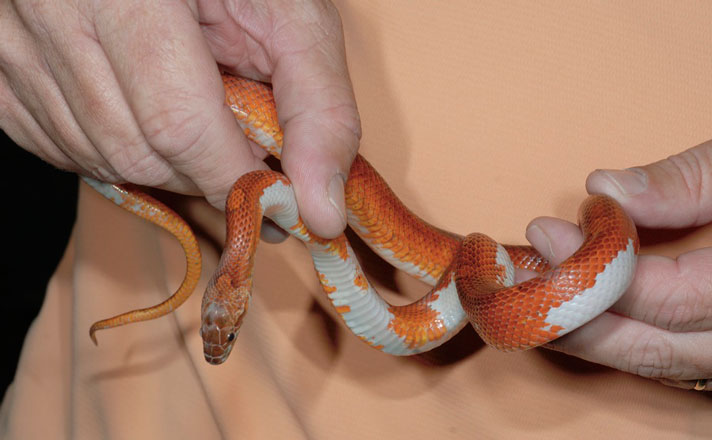
bill love
Pied-sided blood-red corns show a spectacular effect caused by an enhanced diffusion trait in which random unpigmented splotches appear on the lower sides.
Color alone does not complete the canvas. Pattern can be just as important. Bloodreds seem to offer opportunities to use both color and pattern. They have been around for a long time but still are not totally understood genetically. It appears that the diffusion trait is what causes the blurry side pattern that transfers so well to other non-red colors, and it can turn other color combos into an almost-patternless snake.
New, individual mutant genes aren’t discovered every year, but with each new discovery comes the possibility of combining it with all of the previously discovered traits, resulting in a seemingly infinite number of new looks for the corn snake.
Accompanying this article are photos of some the most beautiful corns produced so far. Some are produced through selective breeding, some through a single mutation and many through a combination of techniques and mutations.
Kathy Love is the owner of CornUtopia, and she has specialized in corn snakes for decades. She works alongside her husband, photographer Bill Love, and helps him run his company, Blue Chameleon Ventures, which leads nature tours to view herps in Madagascar.

